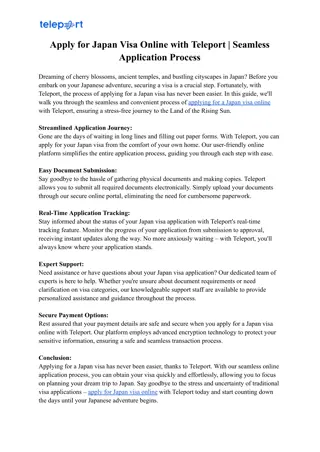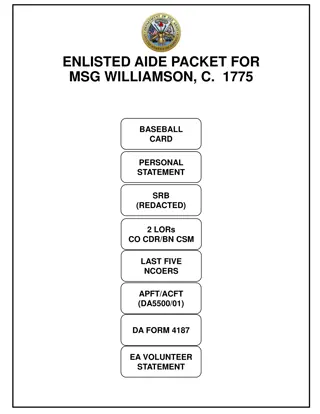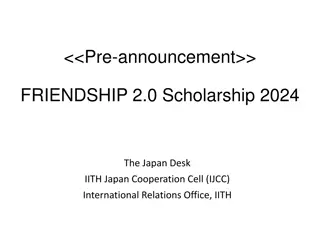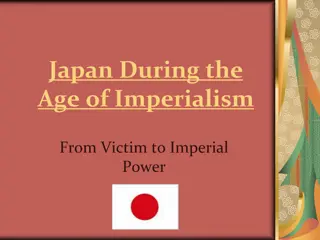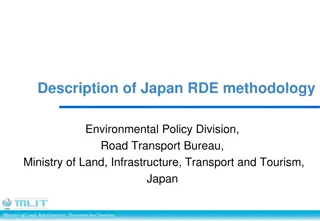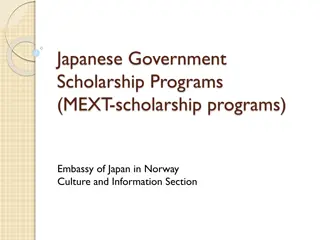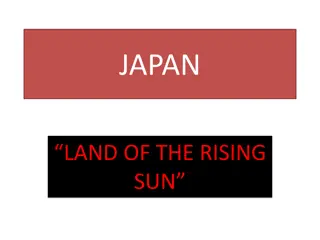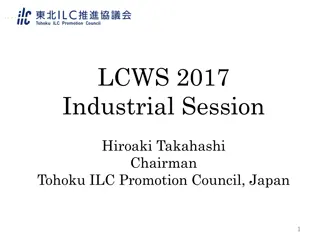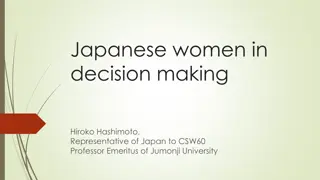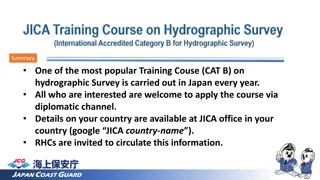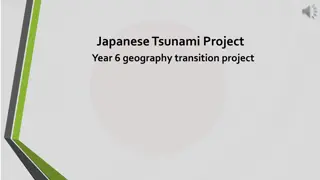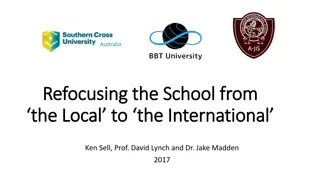Education in Japan - Daniel Williamson
Discover insights into the education system in Japan through the eyes of Daniel Williamson. Gain a unique perspective on the challenges and innovations shaping education in this East Asian country. Explore the cultural influences, teaching methodologies, and student experiences that define the educational landscape of Japan. Dive into this engaging narrative to deepen your understanding of education practices in a global context.
Download Presentation

Please find below an Image/Link to download the presentation.
The content on the website is provided AS IS for your information and personal use only. It may not be sold, licensed, or shared on other websites without obtaining consent from the author.If you encounter any issues during the download, it is possible that the publisher has removed the file from their server.
You are allowed to download the files provided on this website for personal or commercial use, subject to the condition that they are used lawfully. All files are the property of their respective owners.
The content on the website is provided AS IS for your information and personal use only. It may not be sold, licensed, or shared on other websites without obtaining consent from the author.
E N D
Presentation Transcript
Education in Japan Daniel Williamson
Population of Japan With 126,702,133 people, Japan is 11thin population among the nations of the world (Image and data source: https://www.cia.gov/library/publications/the-world-factbook/geos/ja.html)
Economy of Japan Exchange rate: 107.1 yen equal 1 U.S. dollar International trade: The nation ranks 5th in total exports and 5th in total imports Inflation rate: At negative 0.1% in 2016, Japan is teetering between inflation and deflation Size of labor force: 65,930,000 persons, which ranks Japan 9th in the world Unemployment rate: 3.2 % Population below poverty line: 16.1% GDP: The nation ranks 5th GDP growth in 2016: 0.5%, which ranks 187th GDP per capita: $38,900, ranking Japan 41st The national public debt is a whopping 234.7% of GDP, which is the highest in the world *Note: The rankings include the European Union, comprised of several nations (Source: https://www.cia.gov/library/publications/the-world-factbook/geos/ja.html)
MEXT: Japans Ministry of Education, Culture, Sports, Science, and Technology Image source: http://www.mext.go.jp/en/about/organization/title01/detail01/__icsFiles/artimage/2017/05/01/ce5abo0012/1374476_001.jpg
Prefectures and municipalities have boards of education Image source: http://www.digi-joho.com/images//map_japan.gif
At a glance: Japanese schools Image source: http://www.mext.go.jp/en/policy/education/overview/__icsFiles/artimage/2016/06/29/ce4edu0002/1373792_001_2.jpg
Japanese School Calendar Three terms per year for elementary and secondary schools 1. April-July 2. September-late December 3. January-March There has been discussion about changing the school calendar to begin in September in order to attract more exchange students, yet change is unlikely. (Source: http://web-japan.org/kidsweb/explore/calendar/april/schoolyear.html) Two semesters, usually, for Japanese universities 1. April-August 2. September-February (Source: http://global.chuo-u.ac.jp/english/unicms/wp- content/uploads/2014/03/Academic_Year_and_Academic_Calendar.pdf)
Enrollment statistics as of May 1, 2015 1,943 integrated early childhood education and care centers enrolled 281,136 students 11,674 kindergartens enrolled 1,402,448 students 20,601 elementary schools enrolled 6,543,104 students 1,114 special needs education schools enrolled 137,894 students 52 combined junior and senior high schools enrolled 32,317 students 10,484 junior high schools enrolled 3,465,215 students 4,939 senior high schools enrolled 3,319,114 students 3,201 specialized training colleges enrolled 656,106 students 57 colleges of technology enrolled 57,611 students 1,229 miscellaneous schools enrolled 117,727 students 346 junior colleges enrolled 132,681 students 779 universities enrolled 2,860,210 students, of which 249,174 were graduate students (Source: http://www.mext.go.jp/en/publication/statistics/title02/detail02/1379369.htm)
Student achievement at elementary and secondary levels is phenomenal As of 2015, Japanese 15-year-olds were among the world s best achievers in reading, math, and science (source: http://www.mext.go.jp/en/news/topics/detail/1380580.htm) In fact, in science, only Singapore s 15-year-old boys scored better than Japan s, while only Singapore s, Finland s, and Estonia s 15-year-old girls outscored Japan s (source: https://data.oecd.org/pisa/science-performance-pisa.htm#indicator-chart) At younger ages, too, Japanese students were among the world s best in math and science (source: http://www.mext.go.jp/en/news/topics/detail/1380456.htm)
Japan wants more collaboration at the community level to support schools http://www.mext.go.jp/en/news/topics/detail/__icsFiles/afieldfile/2016/12/06/138027 0_001.pdf The link above has an illustrated guide for Japan s future plans for school governance for elementary and secondary education Community schools for primary and secondary education are the wave of the future and are the main focal point of Japan s regional revitalization plans Schools are to be the centers of the communities Even adults will be able to access community-sponsored informational forums at the schools Instead of volunteers helping schools on an individual basis, they will be networked through School Management Council Systems Schools will be shaped more by community influence than ever before All local entities (parents, businesses, labor unions, universities, etc.) are stakeholders
Elementary and secondary school teacher professional development goals Japan wants teachers to be better managers of the classroom (bullying appears to be one of the problems in need of resolution through better classroom management) Collaboration, such as what is envisioned within the Community Schools initiative, is the main tool to be used in fostering the professional development of teachers already working in the field The main thrust of improving the quality of teaching, though, is at the university while students are preparing to become teachers Japan proposes three teacher certification levels geared toward incentivizing teachers to obtain masters degrees Not enough of the universities offer graduate programs in education, and those that exist need strengthening, greater enrollment capacity, and more diversification More expertise is needed in special education Global competition is the impetus for encouraging teacher candidates to study abroad (Source: http://www.mext.go.jp/en/publication/report/title01/detail01/__icsFiles/afieldfile/2016/10/12/137 8129_001.pdf)
Japanese higher education reform Japan does well with quantitative and objective research, but not qualitative and subjective research The enhancement of qualitative scholarly activities would help students develop critical thinking skills, ethical philosophies, creative and conceptual capabilities, and especially, because circumstances are always fluid and the future is so unpredictable, heuristics for making pivotal decisions Ramping up students to develop these capabilities needs to begin in secondary school, but most of the reforms are needed at the university level The universities engage in much research, but lack rigor in the undergraduate classroom 1. Selectivity in admitting new students has become more lax 2. Students spend much fewer hours studying than they did when they were younger 3. Faculty are generous in awarding good grades 4. No centralized curriculum to use as benchmarks all faculty set their own agendas for their classrooms A major recommendation is to develop curricula across disciplines and universities (Source: http://www.mext.go.jp/en/publication/report/title01/detail01/__icsFiles/afieldfile/2016/12/ 06/1380275_001.pdf)
The future of strategic basic research In mid-2014, a blue-ribbon panel reported on the research needs of the government and its universities (corporate R&D was not within the scope of the report) 1. Use-inspired research: Generating social and economic value by figuring out how to turn scientific knowledge into new technologies that are useful 2. Task-defined research: Troubleshooting a narrowly defined problem, with solutions usually generated within a relatively short timeframe 3. Concept-oriented research: Envisioning the future, guiding the future, anticipating paradigms that will become outmoded and conjuring up new paradigms to replace them Of these three, concept-oriented research requires the most support from the government in order to sustain it, for the timeframe for this type of research is very long and ongoing without generating much monetary value The benefits from concept-oriented research include the capacity to be proactive, to manage the future, rather than be reactive, caught off guard by future events, and slow to respond (Sources: http://www.mext.go.jp/en/publication/report/title02/detail01/1373665.htm and http://www.mext.go.jp/component/english/__icsFiles/afieldfile/2014/10/09/1352423_01.pdf)


